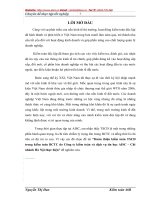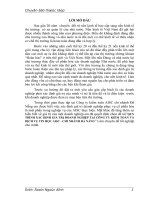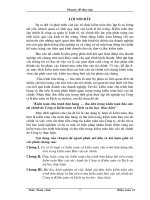ISA 1 tổng quan kiểm toán và dịch vụ đảm bảo
Bạn đang xem bản rút gọn của tài liệu. Xem và tải ngay bản đầy đủ của tài liệu tại đây (3.48 MB, 41 trang )
Auditing and Assurance
Services in Australia
By Grant Gay and Roger Simnett
Slides prepared by Roger Simnett
Copyright © McGraw-Hill 2006
Copyright 2006 McGraw-Hill Australia Pty Ltd
Revised PPTs t/a Auditing and Assurance Services
in Australia 3e by Grant Gay and Roger Simnett
1-1
Part One
The Auditing and Assurance
Services Profession
Copyright 2006 McGraw-Hill Australia Pty Ltd
Revised PPTs t/a Auditing and Assurance Services
in Australia 3e by Grant Gay and Roger Simnett
1-2
Chapter 1
Assurance and Auditing:
An Overview
Copyright 2006 McGraw-Hill Australia Pty Ltd
Revised PPTs t/a Auditing and Assurance Services
in Australia 3e by Grant Gay and Roger Simnett
1-3
Introduction: An overview of the current
auditing environment
•
2001-2003 Developments:
–
Resultant crisis of confidence in financial system:
Numerous corporate collapses (Enron, HIH, One.Tel etc)
Collapse of major auditing firm (Arthur Andersen)
Auditor value questioned during this period.
Copyright 2006 McGraw-Hill Australia Pty Ltd
Revised PPTs t/a Auditing and Assurance Services in Australia 3e by Grant Gay and Roger Simnett
Slides prepared by Roger Simnett
1-4
An overview of the current auditing
environment
•
2004-2006 Developments:
–
–
–
The auditing profession has gone from strength to
strength.
Society’s need for a strong, independent auditing
profession has been recognised.
There have been many legislative and professional
developments aimed at ensuring (or even increasing) the
auditor’s professional competence and independence.
Copyright 2006 McGraw-Hill Australia Pty Ltd
Revised PPTs t/a Auditing and Assurance Services in Australia 3e by Grant Gay and Roger Simnett
Slides prepared by Roger Simnett
1-5
Overview of the current auditing environment
(Cont.) - some overall developments
•
•
•
•
•
A framework for all assurance services, not just financial
statement audit.
Greater independence in the standard-setting process.
Legislation aimed at improving professional
competence and independence.
Revised auditing standards for financial statement
audits.
Corporate governance and ethics - initiatives.
All these issues and others will be covered in this
course
Copyright 2006 McGraw-Hill Australia Pty Ltd
Revised PPTs t/a Auditing and Assurance Services in Australia 3e by Grant Gay and Roger Simnett
Slides prepared by Roger Simnett
1-6
Learning Objective 1:
The Assurance Framework
•
Many parties provide reports to users as an aid in
making decisions.
• Reports can potentially be biased due to the vested
interests of the report providers.
• Users may demand that the credibility of the report be
enhanced by having an independent expert examine
the report.
• Financial statements are just one type (the most
common type) of report that can be assured.
Copyright 2006 McGraw-Hill Australia Pty Ltd
Revised PPTs t/a Auditing and Assurance Services in Australia 3e by Grant Gay and Roger Simnett
Slides prepared by Roger Simnett
1-7
The objective of assurance engagement
•
Assurance engagement:
‘An engagement in which a practitioner expresses a
conclusion designed to enhance the degree of confidence of
the intended users other than the responsible party about the
outcome of the evaluation or measurement of a subject
matter against criteria’
•
International Framework / AUS 108 para.7
Copyright 2006 McGraw-Hill Australia Pty Ltd
Revised PPTs t/a Auditing and Assurance Services in Australia 3e by Grant Gay and Roger Simnett
Slides prepared by Roger Simnett
1-8
The objective of assurance engagement
Copyright 2006 McGraw-Hill Australia Pty Ltd
Revised PPTs t/a Auditing and Assurance Services in Australia 3e by Grant Gay and Roger Simnett
Slides prepared by Roger Simnett
1-9
Five elements of assurance engagement
•
Three-party relationships
–
–
–
Practitioner (auditor)
Responsible party (preparer)
Intended user
•
Subject matter
• Suitable criteria
• Sufficient appropriate evidence
• Written assurance report
Copyright 2006 McGraw-Hill Australia Pty Ltd
Revised PPTs t/a Auditing and Assurance Services in Australia 3e by Grant Gay and Roger Simnett
Slides prepared by Roger Simnett
1-10
Why is there value in the assurance
service?
•
Independence: users derive value from the knowledge
that a member of the profession has no interest in the
information other than for its usefulness.
• Expertise: assurers must have the competence to
obtain sufficient relevant information to provide a
reasonable basis for their conclusions.
Copyright 2006 McGraw-Hill Australia Pty Ltd
Revised PPTs t/a Auditing and Assurance Services in Australia 3e by Grant Gay and Roger Simnett
Slides prepared by Roger Simnett
1-11
Learning Objective 2:
Structure of Assurance Standards and
Pronouncements
Copyright 2006 McGraw-Hill Australia Pty Ltd
Revised PPTs t/a Auditing and Assurance Services in Australia 3e by Grant Gay and Roger Simnett
Slides prepared by Roger Simnett
1-12
Force of Law Auditing Standards
(1 July 2006)
The force of law auditing standards apply to all audits and
reviews of Corporations Act 2001 financial reports that
commence on or after 1 July 2006, (these would be under
the left branch of figure 1.2):
•
For such audits, the Australian Auditing Standards is
now be designated as ASA’s, and will have to same
numbering as the equivalent ISA’s
• For such reviews, the Australian Auditing Standard AUS
902, is now designated as Australian Standard on
Review Engagements ASRE2410, equivalent to the
International Standard on Review Engagements ISRE
2410.
Copyright 2006 McGraw-Hill Australia Pty Ltd
Revised PPTs t/a Auditing and Assurance Services in Australia 3e by Grant Gay and Roger Simnett
Slides prepared by Roger Simnett
1-13
Levels of assurance
•
For any subject matter, two levels of assurance can be
provided:
–
–
Reasonable assurance
Limited assurance.
Copyright 2006 McGraw-Hill Australia Pty Ltd
Revised PPTs t/a Auditing and Assurance Services in Australia 3e by Grant Gay and Roger Simnett
Slides prepared by Roger Simnett
1-14
Reasonable assurance
Copyright 2006 McGraw-Hill Australia Pty Ltd
Revised PPTs t/a Auditing and Assurance Services in Australia 3e by Grant Gay and Roger Simnett
Slides prepared by Roger Simnett
1-15
Limited assurance
Copyright 2006 McGraw-Hill Australia Pty Ltd
Revised PPTs t/a Auditing and Assurance Services in Australia 3e by Grant Gay and Roger Simnett
Slides prepared by Roger Simnett
1-16
Level of assurance on financial statements
•
•
•
•
•
Reasonable assurance engagements are called audit
engagements.
Reasonable assurance = high assurance,
positive expression of opinion.
Limited assurance engagements are called review
engagements.
Limited assurance = moderate assurance,
negative expression of opinion.
There are also engagements that provide no assurance.
Agreed-upon procedures engagements, report of
factual findings.
Copyright 2006 McGraw-Hill Australia Pty Ltd
Revised PPTs t/a Auditing and Assurance Services in Australia 3e by Grant Gay and Roger Simnett
Slides prepared by Roger Simnett
1-17
Attest v direct reporting
•
Audit and review engagements can involve either an
attest or a direct reporting engagement.
• Attest engagement - auditor issues an opinion on
written assertions made by party responsible for the
subject matter.
• Direct reporting engagement - auditor issues an opinion
directly on the subject matter (no written assertion is
made by the party responsible for the subject matter).
Copyright 2006 McGraw-Hill Australia Pty Ltd
Revised PPTs t/a Auditing and Assurance Services in Australia 3e by Grant Gay and Roger Simnett
Slides prepared by Roger Simnett
1-18
Learning Objective 3:
Auditing Defined
•
A Statement of Basic Auditing Concepts (ASOBAC)
(American Accounting Association) defines auditing as:
–
A systematic process of objectively obtaining and
evaluating evidence regarding assertions about economic
actions and events to ascertain the degree of
correspondence between those assertions and
established criteria, and communicating the results to
interested users.
Copyright 2006 McGraw-Hill Australia Pty Ltd
Revised PPTs t/a Auditing and Assurance Services in Australia 3e by Grant Gay and Roger Simnett
Slides prepared by Roger Simnett
1-19
Auditing Defined (Cont.)
•
The important parts of this definition:
–
–
–
–
–
–
Systematic process — audits are structured activities;
Objectivity — freedom from bias;
Obtaining and evaluating evidence — allows the auditor to
determine the support for assertions or representations;
Assertions about economic actions and events —
describes the subject matter of an audit;
Degree of correspondence…established criteria — the
purpose of the audit is to determine conformity with some
specified criteria; and
Communicating results — the results must be
communicated to interested parties.
Copyright 2006 McGraw-Hill Australia Pty Ltd
Revised PPTs t/a Auditing and Assurance Services in Australia 3e by Grant Gay and Roger Simnett
Slides prepared by Roger Simnett
1-20
Learning Objective 4:
Fundamental Principles Underlying an
Audit
• In 2005 the International and Australian Auditing
Standards Boards released a draft consultation paper in
which they outlined possible fundamental principles
underlying an audit. These principles should:
–
–
–
–
underpin the objective(s) of an audit, and help drive the
conduct of the auditor in using professional judgment to
meet the professional requirements of the auditing
standards;
be easily understood both by auditors and other readers
of auditing standards;
be universally applicable to all audits; and
entrench the expectations that auditors are expected to
accept and abide by.
Copyright 2006 McGraw-Hill Australia Pty Ltd
Revised PPTs t/a Auditing and Assurance Services in Australia 3e by Grant Gay and Roger Simnett
Slides prepared by Roger Simnett
1-21
Draft ethical principles
•
•
•
•
•
Integrity
Objectivity
Professional competence and due care
Confidentiality
Professional behaviour.
Copyright 2006 McGraw-Hill Australia Pty Ltd
Revised PPTs t/a Auditing and Assurance Services in Australia 3e by Grant Gay and Roger Simnett
Slides prepared by Roger Simnett
1-22
Draft auditing principles
•
•
•
•
•
•
•
•
•
•
Knowledge
Responsibility
Quality control
Rigour and scepticism
Professional judgment
Evidence
Documentation
Communication
Association
Reporting
Copyright 2006 McGraw-Hill Australia Pty Ltd
Revised PPTs t/a Auditing and Assurance Services in Australia 3e by Grant Gay and Roger Simnett
Slides prepared by Roger Simnett
1-23
Learning Objective 5:
Attributes of Accounting Information
•
From AASB/IASB framework:
–
–
–
–
Relevance
Reliability
Comparability
True and fair presentation
These four attributes of accounting information provide the
basis for the audit function.
Copyright 2006 McGraw-Hill Australia Pty Ltd
Revised PPTs t/a Auditing and Assurance Services in Australia 3e by Grant Gay and Roger Simnett
Slides prepared by Roger Simnett
1-24
Learning Objective 6:
Demand for Assurance
•
Demand arises because users are not in a position to
establish the credibility of the information they are
presented with. This may be due to:
–
–
–
–
Conflict of interest — managers may present biased
information as they are also evaluated on the information;
Consequence — information provided forms the basis of
many users’ decisions;
Complexity — many users do not have the expertise
required to determine the quality of information
presented; and
Remoteness — the separation of owners from
management prevents users from assessing information
quality.
Copyright 2006 McGraw-Hill Australia Pty Ltd
Revised PPTs t/a Auditing and Assurance Services in Australia 3e by Grant Gay and Roger Simnett
Slides prepared by Roger Simnett
1-25









